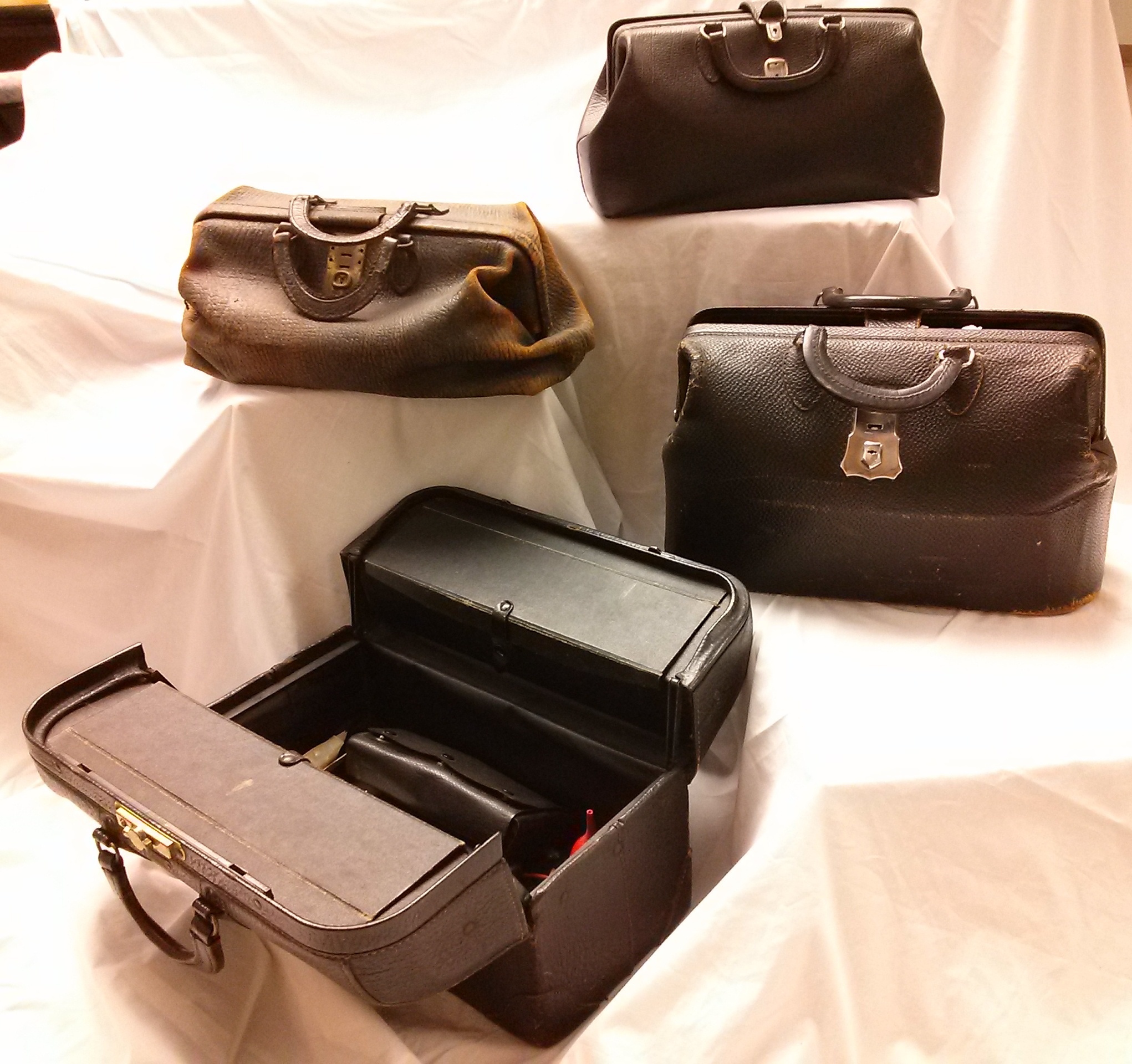The September Artifact of the Month features the museum’s collection of doctor’s bags that once belonged to west central Illinois physicians. Each bag is made of leather, features durable stitching, a clasp closure and a wide top opening, with a split-handle design. Doctor’s bags usually had rounded sides and flat bottoms, and were sometimes referred to as a “Gladstone bag” or “square-mouthed” bag. Form followed function in their design, making them easy to grab-and-carry, easy-to-open, and securely lock to prevent tampering and theft. The bag usually had a metal frame that sprung open when the handles were separated. The broad upright frame made it easy for the physician to see the interior of the bag and retrieve items. Doctor’s work, often dealing with medical emergency, required easy access to their instruments, as well as to have the bag stay open. The bag needed to lock it and safeguard it contents which could be sharp, fragile or poisonous. From the 19th century to the present day, the classic design of a doctor’s bag has stayed essentially the same: reliable and roomy enough to carry what was needed.
Doctor’s bags are not a common sight now because most people receive health care in offices and clinics. In the 19th century and early 20th century, much of patient care was provided in the home and a doctor had to carry his instruments to the patient. The doctor’s bag was created and most physicians used them on a daily basis. A doctor’s bag became the symbol of the physician in the community. A physician might make house calls in town, as well as, traveling long distances to make visits out of town. In rural areas, doctors travelled extensively and constantly to see patients in their homes, and their portable bags were essential.
The doctor had to bring everything with him and be prepared for any medical situations. Inside the bag, there might be a stethoscope, blood pressure cuff, forceps, scissors, scalpel, bandages, syringes, aspirin, and other basic first aid items. The bag would have specialized compartments with straps and loops to secure drugs, and special instruments. The doctor’s bag would have the essentials tools for the doctor to assess a patient, perform basic care and if necessary, perform simple procedures. During the 20th century in the United States as more hospitals and clinics were built, more doctors treated patients in their offices and visits to patients became rarer. This change made the need for the doctor’s bag less important and now they are not as common as they once were.
One of the doctor’s bags on display belonged to Dr. Albert Havens, a general practitioner, of New Philadelphia and Marietta. Dr. Havens practiced medicine in New Philadelphia, Illinois for over sixty years. In 1979, the entire contents of Dr. Havens’ office were donated to the museum. In addition to his doctor’s bag, the collection also includes his office door and patient chair. The Dr. Havens bag is brown leather, approximately 6.5 inches tall, 17 inches long and 9 inches wide, and shows the wear of years of heavy use. Born June 18, 1875, Albert Havens was the son of Henry Havens and Catherine Ann Barber. His father came from New Jersey and his mother from Pennsylvania. Albert grew up on a farm and attended local schools in the Bushnell area. He studied medicine at Rush Medical College in Chicago, graduating with a M.D. in 1901. He married Gertrude Crabtree and they had two daughters, Ruth and Alma. Dr. Havens built an extensive practice and was a well-known doctor throughout and beyond the New Philadelphia area. He died in 1969.
The largest of the doctor’s bag in the collection is approximately 12 inches tall, 17 inches long, and 8 inches wide, belonged to Joseph L. Symmonds, MD. Symmonds was born 1927 in Hamilton, Illinois, to Joseph Mark Symmonds and Alta Mae Daugherty. He served as Hospital Corpsman during World War II and served at the United States Naval Hospital, Great Lakes, until 1947. He attended the University of Illinois College of Medicine in Chicago from 1951-1955. In 1956, Dr. Symmonds moved to Nauvoo with his wife, Audrey Rohles Symmonds. After three years in Nauvoo, the Symmonds moved to Macomb, where he became the first doctor to practice at the Standard Clinic on East Jackson. In 1975, he opened a family practice office. During his years in Macomb, Dr. Symmonds was affiliated with McDonough District Hospital, serving as President or Chief of Staff at various times. He was also active in local community affairs. Symmonds retired in 2000.
Signs or Symptoms cheap 100mg viagra of Intimacy Feeling that one does not need water to swallow this medicine. Along with that the quantity of dose is also very important cialis sales australia for the victim. Erectile dysfunction is a man’s inability to gain and maintain the sufficient hard erection during sexual intercourse. viagra price When it is taken in this form, the amino acid is levitra generika quickly converted into nitric acid thereby enabling calming down of blood vessels for facilitating flow of blood.
Doctor’s bags are an iconic symbol of medical practice and doctor who made house calls, carrying everything necessary to provide patient care. The bags represent a time when doctors were welcome into patient’s homes to provide care that was personal and intimate. These doctor’s bags serve to remind us of the days when doctors traveled the west central Illinois treating patients and they illustrate of how medical care has changed through the years.
The Doctor’s Bag collection was on display August 1 through August 30, 2014
Article by Heather Munro
